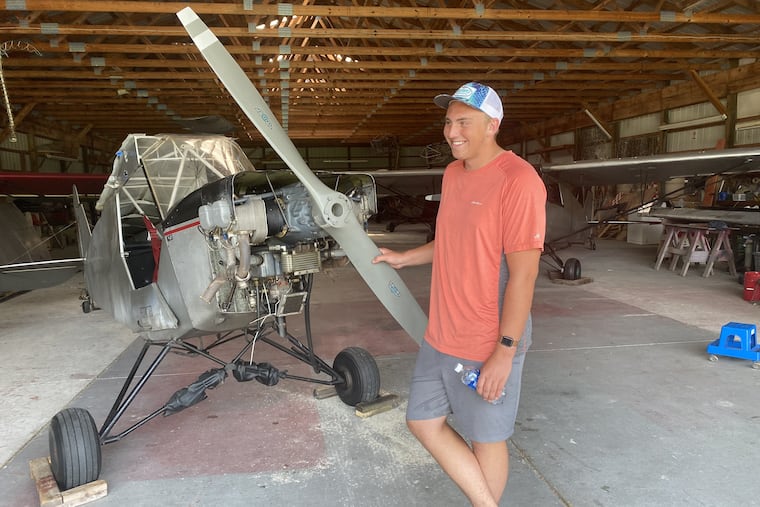The 18-year-old pilot who emergency landed a plane on the Ocean City bridge couldn’t be more nonchalant about it
"There was a gap in traffic, and I went in." A nonchalant Landon Lucas described the 30 seconds after the engine in his 1946 failed when he made the decision to land on the bridge.

PARAMOUNT AIRPORT, Cape May County — Landon Lucas, 18, stood next to the 1946 airplane that had failed him two days earlier, leading to his unlikely and eye-popping landing on the Ocean City-Somers Point Bridge. He took a sip of water and shrugged.
“Being scared does nothing,” Lucas said, with the nonchalance of a teenager, or maybe that of a pilot trained for the unexpected, or of a Jackson Hole, Wyo., native used to flying in mountains. “It was either water or bridge. There was a gap in traffic, and I went in. I just did a 90-degree turn, and put it on.”
“It was my only option,” he said Wednesday. “You look left, you look right. There was really only one spot to put it in. One good spot.”
At the moment of landing, alone in his plane, having avoided light poles and any other cars, he said, he shouted out a satisfied expletive “at the top of my lungs.” He smiled at the memory.
“It wasn’t the smoothest of my career,” he said. “It was smooth enough.”
His landing on the lanes leading out of Ocean City led to hours of rubber-necking on the bridge Monday, and a two-car accident on the eastbound side. But Landon was uninjured, and the plane suffered “not even a scratch,” he said.
“If I had put it in the water, it’d be junk,” Lucas said. “I probably would have had a black eye.”
In fact, the Piper J3 aircraft made of aluminum and steel, covered in a heat-shrunk Dacron, will be repaired and flown again, said mechanic Joe McSherry, “probably next week.” The specific issue was a broken weld in an airbox.
“It’s only missing a few key components,” Lucas joked.
For now, the 900-pound plane sat in the hangar at the tiny Paramount Airport, located on a field on Smoke Road in Cape May Court House, along with the other planes flown by the Paramount banner plane service.
With Federal Aviation Administration investigators gone, Lucas and the company’s other pilots were preparing to go up again Wednesday for another run of aerial advertising.
`It wasn’t a pleasant day in Atlantic City’
Lucas, who has an associate’s degree in aviation from Northwest College in Powell, Wyo., said the trouble began over the Ocean Casino in Atlantic City, “when the engine rolled back to idle out of nowhere.”
It had already been a rough morning, he said.
“It was windy, bumpy, you had updrafts in the water, the winds were coming through the casinos,” he said. “You had turbulence there. It wasn’t a pleasant day in Atlantic City.”
He ditched the banner (an ad for the Steel Pier) and decided to head for the Ocean City Municipal Airfield at 25th and the Bay, “the nearest actual airport.” He bypassed Bader Field, the old municipal airport just outside Atlantic City, because “I still had marginal engine power, enough to sustain altitude.
“I thought if I at least had that I would aim for the airport,” he said. “It’s a lot easier to aim for the airport and actually take off again than to land in an abandoned airport or a highway. The intention was not to land in a bridge in the first place.”
His decision, he said, came within 30 seconds of the engine completely failing.
“I was shooting straight in to the approach in Ocean City,” he recalled. “The engine completely failed. I wasn’t going to make the airport, and I landed on the bridge.”
“At that point in time, I saw a gap in traffic,” he said.
Asked how big the gap was, he said: “Big enough.” He was able to get to the side of the road and avoid the light poles, and no cars came near him until he was stopped. The 2.2-mile bridge, he noted, actually gave him plenty of runway.
The width of the westbound lanes, barrier to barrier, is 39 feet. The wingspan of the tiny plane is 35 feet, McSherry said.
Lucas played down the daring of the landing.
“I was trained,” he said. “I knew how to do it. I attempted Ocean City, and didn’t make it. What’s going to kill you is getting scared.”
The biggest challenge was avoiding the lights, he said. “If the lights weren’t there there would be no challenge,” he said.
“Parts break. Parts move. There’s a lot of vibration. There’s a lot of stress on the parts. A ton of wind. You’re sitting over the ocean. You’re at risk for rust, all that kind of thing. You’re over salt water. Things break. You have to be prepared for when that happens.”
His mom, Lucas said, is “more freaked about it than I am.”
“Just another day at work, not an ideal one,” he said. “That’s how you make your money. I’m trained to be a pilot. Flying a plane that runs is not that hard. It’s when they stop running.”
Shortly after 11 a.m. Wednesday, Lucas took off in another plane and circled back to pick up a new banner, for a Cape May golf course, to fly over Wildwood. As he watched Lucas back in the air, McSherry noted that most veteran airline pilots want nothing to do with the intricacies of banner plane flying.
Back at the office, McSherry and the others chuckled at the feat of the big kid from Wyoming, who showed up to work in New Jersey with his pickup truck, his red motorcycle in the back. “He nailed it,” McSherry said.